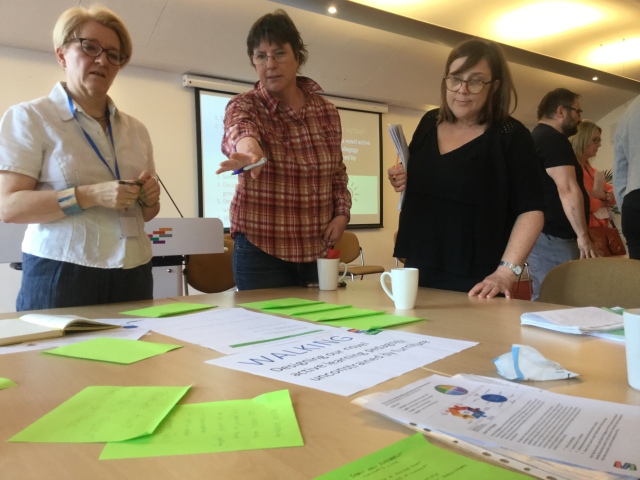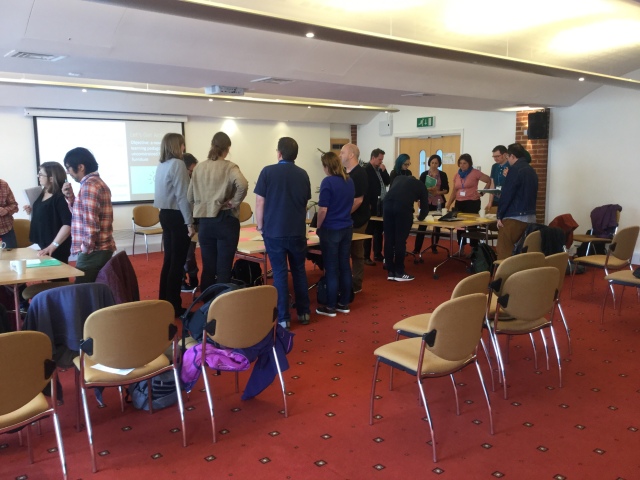
Some of the walking as pedagogy group negotiate options
The Standing, Walking, Crawling workshop I ran at yesterday’s Active Learning Conference worked remarkably well! Here’s the proof. This is what we made when responding to the challenge to design a novel active learning pedagogy unconstrained by furniture. Three groups, three foci… some ideas more developed than others but all inspiring. Thank you to all who participated in the ideation challenge.
Floor-based Learning
- Sit in a circle and roll a ball for the next participant to respond
- Blindfold games
- Twister
- Escape room (floor edition)
- Large scale mind mapping or diagramming
- Obstacle course or problem-solving
- Floor as scattergraph – stand where you are on the graph to capture opinions, answers, and personality, for example
- Mind mapping – everyone creates an item related to the subject matter. Each person becomes their theme. Work as teams to build additional elements based on each theme.
- Moving objects or pictures around.
- Linking ideas on post-it notes on the floor (mind maps)
- Different ideas in different areas – moving to sit with/in a position you want to support.
- Sorting activity – ideas on floor, cruel to sort into a meeting. Chair and watch the structure take shape.
- Moving and sorting items into different spaces.
- Train layout
- Cartography (maps)
- Create a module map/assessment plan across the floor together. Where are the pinch points?
- Sensory, feeling, touching smelling tasting (think of using with social care/nurses/working with individuals with disabilities.
Snakes and ladders concept mapping
Pedagogic rationale: memorable, building community, peer-assisted and collaborative, multidisciplinary.
How does the activity work: Two dice, snakes and ladders board mapped out on the floor. One dice has numbers and the second has concepts/thoughts/ideologies. Students work in teams to agree on answers in response to challenges on the board.
Challenges: space, preparation, accessibility, money, maintaining engagement.
Stand-Up Pedagogy
- Short team discussion studying distance guesses (theoretical).
- Icebreaker activity – throw a ball to another and ask how much do you agree with the statement a place yourself physically
- Gallery walk – small groups looking at and discussing different objects/posters/pictures.
- Questions about specific topics – observations on a paper or graph under discussion
- Whiteboard peer group – whiteboarding writing/drawing/working out problems together
- Collaborative writing on a whiteboard
- Using stations around the room for multiple choice questions
- Dramatisation of an idea
- Roleplay
- Debating groups
- Order yourselves e.g. according to the motion you are given. For example, put yourself in order according to birth dates is a good induction activity. Or, people can be labeled to represent parts of a process or critical path and they have to negotiate their positions and dependencies.
- Students stand back to back and ask each other questions about what they want to know about a topic
- Take students on a bus ride, standing, talking and reflecting. Get off and on again.
Physical ranking, ordering or positioning
Can be used in various contexts – as an icebreaker or to explore conceptual debates.
Outcome statement: By taking part in this activity you will have developed your understanding of theoretical positions and how to communicate conceptual thinking in small and large groups.
Pedagogic rationale: visual and kinetic movement and ownership of learning, or conceptual positioning, through comparison of preferences. Quick assessment of learning (or not).
How does the activity work: To track, review and summarise key concepts students physically position themselves along an axis
Negotiate positioning through a series of back-to-back debates or go back to ranking again.
Follow up in a later session by reversing positions.
Challenges: space, reluctance to debate, size of group, disability.
Walking pedagogies
First thoughts:
- Learning walks – to find authentic examples of a concept
- Maths – symmetry in nature for PGCE students
- Our learning questions – real learning, right or wrong or method of interest
- Learners make own walking groups and then report back
- Identify objects/buildings/people/other from a walk that relate to study theme or topic
- Pedagogy for walking – portrait of business for society: impact pictures students will show the applications of moral theories based on pictures
- Given artefacts is not equal to ideas of a norm– the student will build a story
- Walking to the botanic garden – listing different types of flowers, different types of plants, sharing ideas, explaining something
- Groups start at different places en route with different questions to discuss
- Treasure hunt using QR codes (e.g. Plickers) to collect ideas/concepts/facts
- Active reading – QR codes with a part of the text on the wall (gallery). Students have to summarise, put in order, answer questions.
- Flow schemes – show how different concepts link (whiteboard)
- Poster creation – create a poster that explains a concept (e.g. a film poster representing the film of your idea!)
- Journal – students identify examples that demonstrate theory
- Walking scrabble – have large letters to play scrabble or crosswords recycling key vocabulary. Can be played by individuals or in pairs.
Second thoughts:
Discovering learning
Outcomes: To link theory to practice
Pedagogic rationale: Interpersonal active learning – connecting the world to the curriculum.
Description: Walk around collecting ‘evidence’ of a theme or idea relating practice/examples to concepts.
Challenges: risk assessment, clear briefing.
Other notes: Capture ‘items’ in photos, cost, access – a ‘virtual’ walk.

Who needs furniture? Discarded chairs during ideation activity
